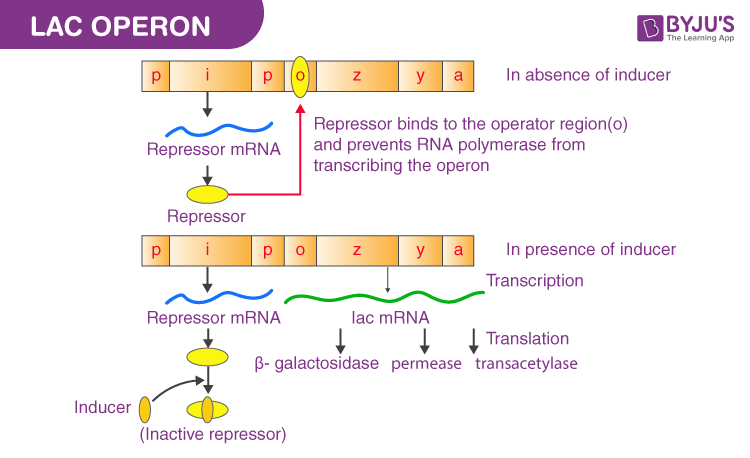“Gene regulation can be defined as any kind of alteration in the gene to give rise to a different expression which might result in a change in the synthesized amino acid sequence.”
Gene expression is basically the synthesis of the polypeptide chain encoded by a particular gene. Therefore, we can say that the expression of the gene can be quantified in terms of the amount of protein synthesised by the genes.
Let’s learn about the regulation of gene expression in prokaryotes with the example of Lac Operon.
Regulation of Gene Expression
We can infer that the gene regulation can take place at various steps of gene expression which includes the following:
- Replication level – Any error in copying the DNA may result in an altered expression.
- Transcriptional level – During transcription, any error in the polymerization may again lead to a change in expression of the gene.
- Post-transcriptional level – During the post-transcriptional modification i.e., RNA splicing, there may be some changes.
- Translational level – During translation, if there is an error in the attachment of mRNA to the tRNA molecules, there may arise some changes.
The regulation of the expression of the gene can be explained with the example of an enzyme, say peroxidase in bacteria. This enzyme catalyzes the hydrolysis of hydrogen peroxide to water and oxygen. Now, if the bacteria are moved to another environment where they fail to manufacture hydrogen peroxide, the enzyme no longer plays its role. In such a situation, the bacteria will not synthesize the enzyme anymore. Thus, we can say that the environmental, metabolic and physiological condition regulates the expression of genes.
Also Read: Protein Synthesis
Gene Regulation in Prokaryotes
Gene regulation in prokaryotes is most extensively observed at the initiation of transcription. Thus, the gene expression during transcription initiation is affected by regulation. The regulation usually takes place in the expression of the RNA polymerase at the promoter site. This affects the accessory proteins which bind to the recognition sites. These accessory proteins can regulate the promoter site in two ways:
- Positive regulation by activators
- Negative regulation by repressors
In Operons, the operator is situated right next to the promoter where the regulator binds to control its entire functioning.
Lac Operon
“Lac operon is an operon or a group of genes with a single promoter that encode genes for the transport and metabolism of lactose in E.coli and other bacteria.”
Lac Operon Concept

Gene regulation in prokaryotes can be explained with the help of the Lac Operon model. Here the alteration in physiological and environmental conditions can be observed leading to an alteration in expression in prokaryotes. It was observed by Jacob and Monod. The lac operon consists of:
- Regulatory gene i – It codes for the repressor protein.
- z gene – It codes for beta-galactosidase which catalyzes the hydrolysis of lactose into glucose and galactose.
- y gene – It codes for permease which regulates the lactose permeability in the cell.
- a gene – It codes for transacetylase which assists the enzyme beta-galactosidase.
Hence, all these genes help in lactose metabolism. In lac operon, lactose acts as an inducer. If lactose is provided in the medium for the bacteria, the regulatory gene is activated. The inducer will bind to the repressor protein and render it inactive which allows transcription of the operon. Thus, the lac operon is negatively regulated in this case.
Gene Regulation in Eukaryotes
Gene regulation in eukaryotes is regulated by transcriptional activators and repressors. The repressors bind to specific DNA sequences and inhibit transcription. In eukaryotes, transcription involves several steps. It occurs in both, nucleus (transcription) and cytoplasm (translation).
Lac operon Notes
- Lac operon contains genes involved in metabolism.
- The genes are expressed only when lactose is present and glucose is absent.
- The operon is turned on and off in response to the glucose and lactose levels: catabolite activator protein and lac repressor.
- The lac repressor blocks the transcription of the operon. In the presence of lactose, it stops acting as a repressor.
- catabolite activator protein activates the transcription of the operon, only when glucose levels are low.
Also Read: Difference between genes and DNA
Stay tuned with BYJU’S to learn more about Lac Operon concept, diagram and Regulation of Gene Expression in prokaryotes and eukaryotes. You can also refer to the lac operon notes mentioned here for the better understanding of the concept.

usefull information.
Nice❣️
Lac operon